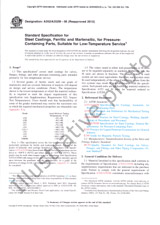We need your consent to use the individual data so that you can see information about your interests, among other things. Click "OK" to give your consent.
ASTM D1120-22
Standard Test Method for Boiling Point of Engine Coolants
Translate name
STANDARD published on 1.9.2022
The information about the standard:
Designation standards: ASTM D1120-22
Publication date standards: 1.9.2022
SKU: NS-1084174
The number of pages: 3
Approximate weight : 9 g (0.02 lbs)
Country: American technical standard
Category: Technical standards ASTM
The category - similar standards:
Annotation of standard text ASTM D1120-22 :
This test method establishes the standard procedures for the determination of the equilibrium boiling point of engine coolants. The equilibrium boiling point indicates the temperature at which the sample will start to boil in a cooling system under equilibrium conditions at atmospheric pressure. This method requires the use of the following apparatuses: round-bottom, short-neck, heat-resistant glass flask; water-cooled, reflux, glass-tube type condenser; grit No. 8 boiling stones of silicon carbide grains; partial immersion thermometer; and electric heating mantle as heat source. Specified amounts of the sample shall be boiled under equilibrium conditions at atmospheric pressure in the flask. The temperature of the liquid corrected for barometric pressure shall be the boiling point.
Keywords:
boiling point, engine coolant,, ICS Number Code 71.100.45 (Refrigerants and antifreezes)
Additional information
| 1. Scope | ||||||
|
1.1?This test method covers the determination of the equilibrium boiling point of engine coolants. The equilibrium boiling point indicates the temperature at which the sample will start to boil in a cooling system under equilibrium conditions at atmospheric pressure. Note 1:?Engine coolants may also be marketed in a ready-to-use
form (prediluted). This test procedure is applicable to diluted
solutions as well as to concentrates.
Note 2:?The procedure for obtaining a representative test
sample of a coolant solution that contains an antileak additive is
found in Practice D1176.
1.2?The values stated in SI units are to be regarded as standard. The values given in parentheses after SI units are provided for information only and are not considered standard. 1.3?This standard does not purport to address all of the safety concerns, if any, associated with its use. It is the responsibility of the user of this standard to establish appropriate safety, health, and environmental practices and determine the applicability of regulatory limitations prior to use. 1.4?This international standard was developed in accordance with internationally recognized principles on standardization established in the Decision on Principles for the Development of International Standards, Guides and Recommendations issued by the World Trade Organization Technical Barriers to Trade (TBT) Committee. |
||||||
| 2. Referenced Documents | ||||||
|
We recommend:
Technical standards updating
Do you want to make sure you use only the valid technical standards?
We can offer you a solution which will provide you a monthly overview concerning the updating of standards which you use.
Would you like to know more? Look at this page.




 Cookies
Cookies
